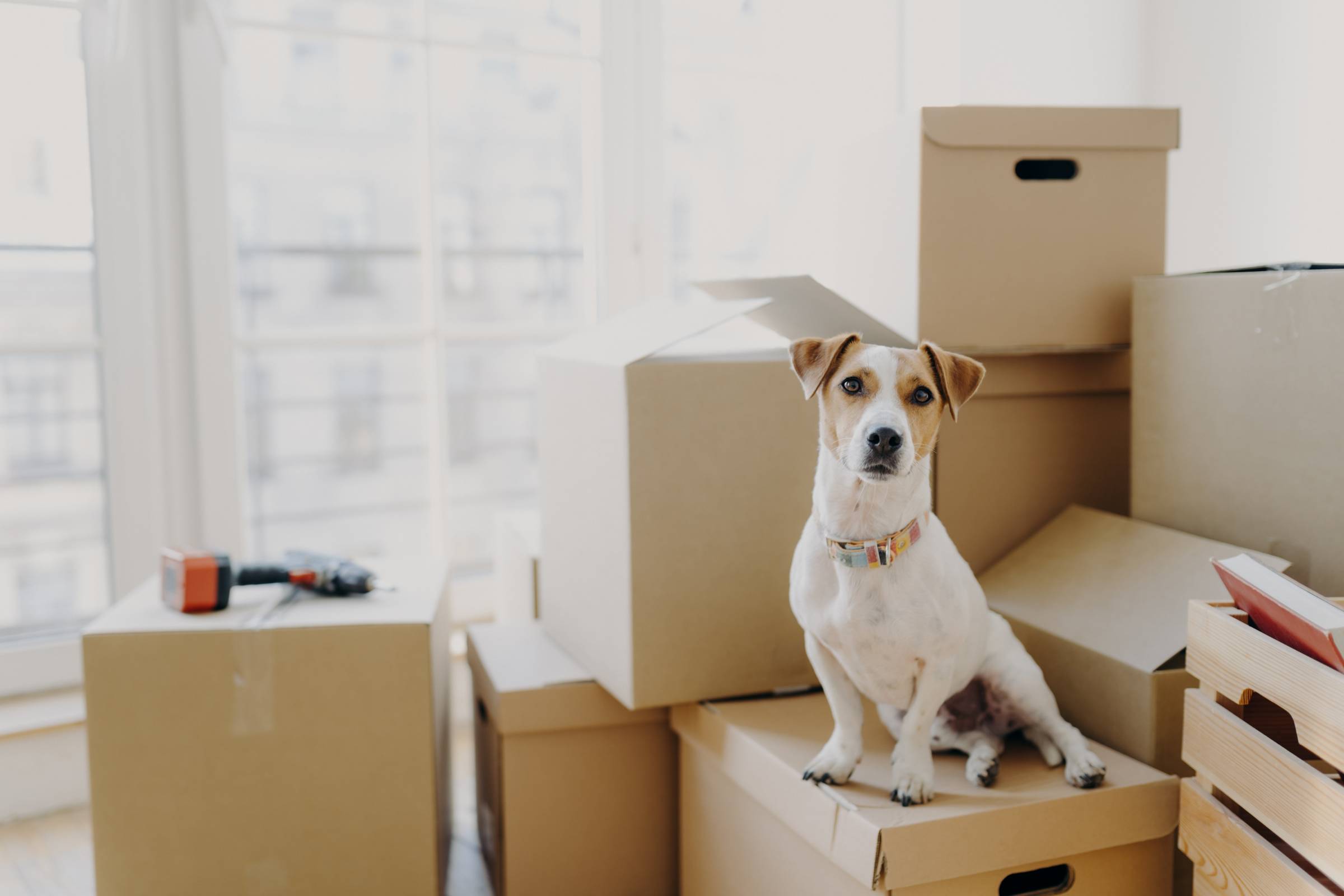- Home/
- Costs/
- Pet Transport/
- Pet Transport Cost

Pet transport cost: Why crate sized matter?
Get a free quote nowPost to find a price. It's free and only takes a minute.
Price guide
$100 - $1,000
low
$100
median
$350
high
$1,000
Last Updated on
Key Facts
- Pet transport services charge differently depending on the crate size, with small crates starting at $490.
- Depending on your chosen airline, small animals may fly in-cabin on some flights, while large pets must travel as cargo on others.
- Timing your pet transport strategically outside rush hours can significantly reduce pet taxi fees during the pickup/delivery stages.
Moving to a new home with a pet? You might be wondering how to get your four-legged friend there safely and without stress. While it may seem as simple as bringing them along for the ride, pet transport is actually a bit more complex. It actually involves vet checks, special carriers, paperwork, and sometimes customs clearance if you’re crossing borders.
In the U.S., pet courier services typically cost between $100 and $300 for short-distance domestic trips, while long-distance journeys range from $350 to $600. If your pet is flying, air transport costs can start at around $275 and climb to over $1,000, depending on the airline, distance, and pet size.
In this post, we’ll break down exactly what drives these costs and how you can choose a reliable, stress-free transport option for your furry companion when moving to a new home.
Average pet transport cost based on crate size
One key factor that affects pet transport pricing is the size of the crate your pet will travel in. Transport companies calculate costs based on crate dimensions because they directly influence how much space is needed, especially for air cargo or long-distance road travel. Larger crates require more room and may also need additional handling, which can drive up the overall cost.
Crate size is typically determined by your pet’s breed, weight, and measurements to ensure they have enough space to stand, turn, and lie down comfortably during the journey. Below is a general breakdown of average transport costs based on standard crate sizes:
| Breed Size/ Corresponding Crate |
Transport cost |
|---|---|
Small |
$490 |
Medium |
$520 |
Medium+ |
$545 |
Intermediate |
$575 |
Large |
$630 |
X-Large |
$735 |
Giant |
$845 |
These estimates can vary depending on the distance, mode of transport, and any additional services like pickup, delivery, or customs clearance. For the most accurate quote, it’s always best to speak directly with a professional pet transporter who can assess your specific needs. A man transporting a big dog. (Source: iStock)
A man transporting a big dog. (Source: iStock)
Factors affecting pet transport costs
1. Travel crates
Airlines would most likely require travel crates for your pet, whether for in-cabin travel or in the cargo hold. The larger the crate, the more expensive it gets. For instance, a dog crate can cost $50 to $400. Many pet transport services also offer to supply these crates, along with beddings, bowls, litter boxes, collars, leashes, and bottled water.
Your pet's crate should be tall enough for them to stand up. They shouldn't have to duck to see out of the crate. The crate should also be wide enough for your pet to turn around easily and long enough for them to lie down comfortably with their paws extended.
Moreover, the crate should comply with the regulations of the United States Department of Agriculture and the International Air Transport Association. In general:
It should be made of hard plastic, metal, or wood. The top part should be solid (no ventilation or top doors).
The crate door must be made of metal (no hard plastics and other materials allowed!). It should also securely close.
Kennels should be assembled properly and have quality hardware. Note that kennels with plastic side latches are usually not allowed.
Don't forget to affix two water dishes to the inside of the kennel door.
Check if the floor is solid and leakproof. You can also place an absorbent towel at the bottom of the crate.
If your dog is too big, you might need to get a custom-made travel crate that complies with standards for international travel. Also, double-check with your airline if larger crates like this are allowed.
2. Vet visits
A vet visit is crucial to ensure that your dogs, cats, or other pets are healthy and fit for travel. Complete vaccination records, blood tests, health checks, and microchipping by a government-accredited veterinarian might also be essential when moving internationally. The cost of a simple domestic health certificate already varies between vets, from $75 to $250. A pet grooming appointment before transport also helps since clean pets typically pass inspection with fewer issues. costs with your vet.
3. Airline tickets and fees
You might need to pay more for your pet than your own airfare. That's because live animals need extra care and attention throughout their travel. For cargo, many airlines use the volume of the travel crate to base the ticket pricing. To fly a small dog like a Chihuahua via cargo, expect to pay around $275 to $300. Large dogs like Great Danes can cost around $1,000 for domestic flights.
4. Ground transportation
Consider ground transportation if you're moving with your pet to a nearby city or state. Pet ground transport costs depend on the distance of the journey. Pet moving prices usually start at $2,200 to $2,400 for a 10-hour drive. Meanwhile, the cost of transporting a pet interstate ranges from $6,000 to $6,400.
5. Pet taxis
If you book a taxi, pet relocation costs depend on the distance from the airport, the number of pets, and the time of day. In New York City, transporting a dog to an airport 10 miles away from a residence costs around $275. So, if you have a tight budget, consider hiring a pet taxi before or after the morning/evening rush hour to avoid premium fees.
 A cat being transported in a car (Source: iStock)
A cat being transported in a car (Source: iStock)
6. Government approvals or endorsements
Pet transportation requires country-specific fees for brokers, taxes, tariffs, and clearances. Airlines usually inform you about these costs upon flight booking. For more information, also check your destination country’s pet transportation policies.
7. Quarantine
Some countries require a quarantine period, so consider the expenses that a quarantine facility entails. These include pet food, bathing materials, and toys. Your pet must have everything they need to stay happy and healthy in a confined space.
Post a task for pet transport
Relocating is a big transition, not just for you but for your pet too. Choosing the right pet transporter can make the journey smoother, safer, and far less stressful for your furry companion. And if you need a temporary solution during the move, trusted pet boarding services can provide a comfortable, caring environment until you’re all settled in.
For a move that puts your pet’s well-being first, turn to Airtasker. From reliable transport to trusted boarding options, you’ll find experienced professionals who treat your pet like their own, so you can focus on moving to your new home with confidence.
FAQs
Here’s a list of who to contact before arranging your pet’s travels:
Your veterinarian
Your chosen airline or travel company
Accommodations if traveling for leisure
Destination state’s animal inspection service to know their regulations
Destination country’s foreign consulate
Book reservations for yourself and your pet at the same time. Remember that airlines often limit the number of pets allowed on each flight. Choose a non-stop flight as much as possible to minimize the stress of changing planes. In warm weather, choose early morning or late evening flights. On the other hand, in colder weather, choose mid-day flights.
If you’re travelling via car, try to make frequent stops (about every 2-3 hours) so that your pet can do their business and get some exercise. Minimize stress by providing your pet with its favorite blanket or toy. Make sure your car is well-ventilated, too.
Find pet transport experts, fast
Post a task
Related articles

Best side hustles for veterinarians
Read more

How much does a pet groomer make?
Read more



